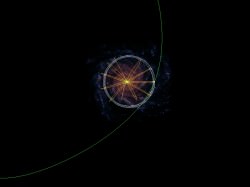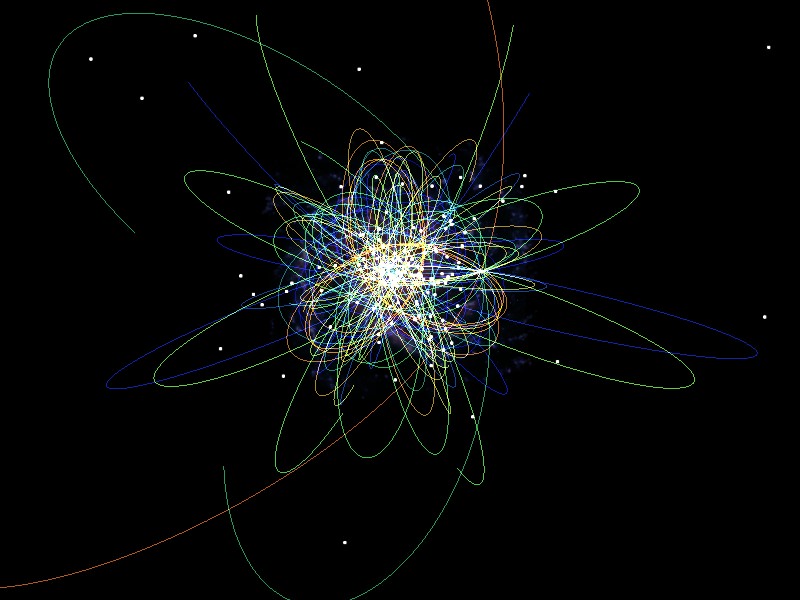[/caption]
A recently discovered type of star called ultracool subdwarfs have unusual and wild orbits unlike any ever encountered, with one such star having an orbit that loops outside and then back into our galaxy. Astronomers have now been able to clarify the origins of these unusual, faint stars that may have come from other galaxies.
“The orbits we calculated for these object are far more diverse than we have originally thought,” said Adam Burgasser of MIT. “One of the stars we studied has an orbit that appears to take it outside the Milky Way galaxy, and it may even have an extra-galactic origin.” Burgasser and colleague John Bochanski of MIT presented their findings on June 9, in a press conference at the American Astronomical Society’s meeting in Pasadena, California.
Ultracool subdwarfs were first recognized as a unique class of stars in 2003, and are distinguished by their low temperatures (“ultracool”) and low concentrations of elements other than hydrogen and helium (“subdwarf”). They sit at the bottom end of the size range for stars, and some are so small that they are closer to the planet-like objects called brown dwarfs. Only a few dozen ultracool subdwarfs are known today, as they are both very faint — up to 10,000 times fainter than the Sun — and extremely rare.
While most stars travel in circular orbits around the center of the Milky Way, ultracool subdwarfs and eccentric and very fast orbits. They appear to be traveling at very high speeds, up to 500 km/s, or over a million miles per hour.
“If there are interstellar cops out there, these stars would surely lose their driver’s licenses,” said Burgasser.
Burgasser’s team of astronomers assembled measurements of the positions, distances and motions of roughly two dozen of these rare stars. Robyn Sanderson, co-author and MIT graduate student, then used these measurements to calculate the orbits of the subdwarfs using a numerical code developed to study galaxy collisions. Despite doing similar calculations for other types of low-mass stars, “these orbits were like nothing I’d ever seen before,” said Sanderson.
Watch this movie of the projected “wild ride” of one of these ultracool subdwarfs (great music!)
Sanderson’s calculations showed an unexpected diversity in the ultracool subdwarf orbits. Some plunge deep into the center of the Milky Way on eccentric, comet?like tracks; others make slow, swooping loops far beyond the Sun’s orbit. Unlike the majority of nearby stars, most of the ultracool subdwarfs spend a great deal of time thousands of light?years above or below the disk of the Milky Way.
“Someone living on a planet around one of these subdwarfs would have an incredible nighttime view of a beautiful spiral galaxy — our Milky Way — spread across the sky,” Burgasser speculated.

Sanderson’s orbit calculations confirm that all of the ultracool subdwarfs are part of the Milky Way’s halo, a widely dispersed population of stars that likely formed in the Milky Way’s distant past. However, one of the subdwarfs, a star named 2MASS 1227?0447 in the constellation Virgo, has an orbit indicating that it might have a very different lineage, possibly extragalactic.
“Our calculations show that this subdwarf travels up to 200,000 light years away from the center of the Galaxy, almost 10 times farther than the Sun,” said Bochanski. This is farther than many of the Milky Way’s nearest galactic neighbors, suggesting that this particular subdwarf may have originated somewhere else.
“Based on the size of its one billion?year orbit and direction of motion, we speculate that 2MASS 1227?0447 might have come from another, smaller galaxy that at some point got too close to the Milky Way and was ripped apart by gravitational forces,” said Bochanksi.
Astronomers have previously identified streams of stars in the Milky Way originating from neighboring galaxies, but all have been distant, massive, red giant stars. The ultracool subdwarf identified by Burgasser and his team is the first nearby, low?mass star to be found on such a trajectory. “If we can identify what stream this star is associated with, or which dwarf galaxy it came from, we could learn more about the types of stars that have built up the Milky Way’s halo over the past 10 billion years,” said Burgasser.
Sources: AAS, MIT (see more images and animations)


If these things are so tiny and faint, then we can only really see the ones that are close to us now, but there must be many, many more of them. And if they’re on elliptical orbits, then they spend most of their time far away from the center of the galaxy just like Halley’s Comet spends most of its time near aphelion.
In other words, these unusual stars spend a lot of their time in Dark Matter land, so we might be able to find out something about it by studying them.
I found myself pondering much the same. Of course some statistics is in need here, but there might be some sort of Virial type of principle or result which could be applied to use a data base on these as a probe of dark matter.
I think one would expect these things to be flying out and about at great velocities – momentum transfer to these things would be huge in 3-body interactions with far more massive objects. There could be a bloody heap of them out there. Let’s coin a catchy yet annoying term for them – ‘dim matter’ anyone?
Most of these are likely to be at comparatively low velocity, where by Kepler they will spend a rather brief period at high velocity at the galactic center. yet there might be a gaggle of these out there and knowledge of their positions and velocities might constitute some statistical data base for understanding dark matter.
Why do people hate Dark Matter so? There’s not way stuff like this is gonna account for about ten times the known luminous matter.
That said, my first thought was that there might be many more of these starlets, if they are indeed that hard to spot.
Trouble is, as it is we don’t even know where half the luminous matter is, so finding a few more stars will only help us to settle the question. And even so by far the largest proportion of ordinary matter in the Universe isn’t locked up in stars. It’s floating freely about as gas (part of why it’s so hard to find, I’m sure).
So DM still wins. And that’s not even getting into the issue of the distribution of light elements in the Universe.
I hope I am not misunderstood here. My point is that these oddball dwarf stars might act as probes of DM. If we got enough statistics on the orbits of these they might reveal data on the distribution of DM around the galaxy. It is pretty clear that these guys are not DM themselves.
A possible objective of observation & measurement (although difficult because the objects are faint to begin with and their length of orbit around the galaxy suggests many years of observation) would be to measure whether these “subdwarfs” change their luminosity during the course of their orbits.
Why might this be important?
Well, in a sense these stars seem to be independent of larger galactic dynamics, one could almost call them, “eratics” that orbit the galaxy independent of any noted galactic structure.
If these stars’ luminosity changes over time and distance, it could be because they are orbiting through various intensity electromagnetic fields that would impact the electric currents flowing into the stars, thus impacting their luminosity according to the ‘Electric Sun’ hypothesis.
On the other hand, if their luminosity remains unchanged and constant even when detected going through different intensity magnetic fields (and more important, their supporting electric currents) this would tend to disprove the ‘Electric Sun’ hypothesis because it relies on electric currents (stellar Birkeland currents) to power stars.
So this is a predictive test that could falsify by ongoing observation & measurement the ‘Electric Sun’ hypothesis.
@Lawrence B Crowell
I think there might be more to learn from these little stars than just what their orbits can tell us. Their chemical makeup could also give us clues about what conditions are like in the galactic halo.
The assumption behind this is that DM interacts with regular matter in some way. DM is horribly weakly interacting with ordinary matter, even itself.
Concerning the matter of the chemical makeup of these stars, has any thought gone into the supposition that some of these stars may be leftovers from earlier disrupted and cannabalized dwarf galaxies that have assumed highly eccentric halo orbits? If the bottom-up theory of galaxy formation is correct, these low mass stars in the galactic halo wouldn’t seem all that improbable. Radial velocity and metallicity observations seem to be in order to try to determine where these stars originated. And yes, these stars would seem to make good probes of the DM distribution in our galaxy.
@Anaconda: what is this “‘Electric Sun’ hypothesis”?
Is it falsifiable?
In which papers, in which peer-reviewed journal(s), have details of this idea been published?
Hanford, good call on that. I am aware there is a gaggle of these dwarf galaxies around the MIlky Way. These seem to occassionally get snagged up with their parent big galaxy. I suppose the angular momentum of these stars reflects a conservation of such in the post coalesence stage.
I can’t comment much more than this. I am not well versed on galaxy structure.
Nereid2: The electric sun? I think it might be in Kesey’s “Electric Koolaid Acid Test,” — wow the colors man! If it’s not in there it might as well be! 🙂
@Anaconda: above you have stated “…in a sense these stars seem to be independent of larger galactic dynamics, one could almost call them, “eratics” that orbit the galaxy independent of any noted galactic structure.” Yes, I suppose that one could call them anything they wish, but ‘modern’ astronomers call them ‘halo objects’ because they are found in the ‘galaxy structure’ called the ‘halo’ ! Also, could you please explain how these objects ‘”seem to be independent of larger galactic dynamics” when they are in orbit around our galaxy?
@Astrofiend: previously you stated “Let’s coin a catchy yet annoying term for them – ‘dim matter’ anyone?” . I though that moniker was already taken by a certain slippery serpent posting here at UT 🙂